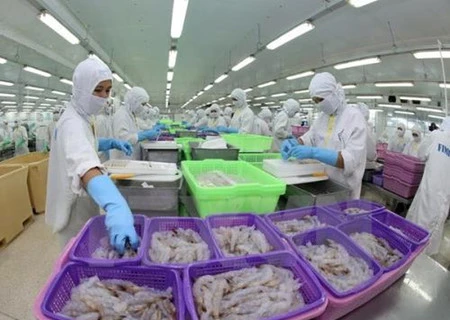HCM City (VNA) – Russia is a potential market for aquatic and agricultural products and consumer goods from Vietnam, especially when the Vietnam-Eurasian Economic Union (EAEU) Free Trade Agreement took effect, many experts have said.
Vietnam – Russia trade accounts for 80 percent of the Southeast Asian country’s total trade with the EAEU, which groups Russia, Belarus, Kazakhstan, Armenia and Kyrgyzstan .
As the Vietnam-EAEU deal came into force on October 5, 2016, Russia now boasts even bigger potential for Vietnamese goods, particularly aquatic and agricultural products, garment and footwear, which are strong export commodities of Vietnam.
Bilateral trade has grown strongly recently with Vietnam’s exports to Russia surging almost 20 percent year-on-year in the first 10 months of 2016, Tran Viet Phuong, deputy head of the Division for Russia and SNG countries at the Ministry of Industry and Trade’s Europe Market Department, said at a workshop in Ho Chi Minh on November 22.
He said the FTA brings about numerous tariff advantages for Vietnam’s key exports to Russia. It is a considerable opportunity for businesses to promote exports to Russia and expand market shares in other EAEU markets.
Tran Duc Hanh, a market research specialist, noted Vietnamese companies own certain advantages when entering the Russian market. While they will benefit from tariff cuts as Vietnam is the first country to ink an FTA with the EAEU, Russia is a large market with high demand for food and consumer goods.
Vietnam and Russia have different strong export items, and therefore they can avoid competition. Aside from effective distribution networks run by Vietnamese people in Russia, the two Governments are also working to enhance their comprehensive cooperation, he said.
Hanh also pointed out certain challenges such as high shipping expenses due to the geographical distance, along with differences in business culture, language and payment practice.
To optimise advantages generated by the Vietnam-EAEU agreement, Vietnamese firms should proactively learn about rules of origin, apply appropriate regulations to improve competitiveness, and align their goods to Russia’s requirements, said experts.
Trade between Vietnam and Russia is estimated at 4 billion USD a year, which is expected to reach 10 billion USD by 2020.-VNA

























